Latest reviews
(This is a probably very subjective review by a novice student of Ammiya (colloquial variety of Arabic).) Though – of course – not exhaustive the website is a very useful dictionary for looking up words or phrases in Egyptian, Levantine and Maghrebi Arabic. Arabic words are given with Tashkil and plurals are provided. Partly, very colloquial words or phrases can be found, which is especially useful.
Things that could be better:
- The data isn’t published under an open license, but “All rights reserved” (unlike for Wiktionary).
- The direction of language of input isn’t recognized automatically, so it has to be set and possibly switched manually.
- The source of the data isn’t really clear to me. https://livingarabic.com/about is only partly helpful. It seems the main author, Hossam Abouzahr, isn’t a philologist, that might be an advantage, but also a risk so to say. And unlike for Lane’s Lexicon which is quoted on the page this dictionary hasn’t been printed by a 19th-century publishing house. So here we don’t have any external warrantor for the accuracy of the information. Also, what are the criteria for a word or phrase to be added? Are there any corpora used? Would be good to know.
- The roots take to much space, on a small (phone) screen this means a lot of scrolling and less overview.
- JavaScript is needed for the website to work (unlike for Wiktionary).
- The website sends data to Google.
- Abbreviations like “ECA” (Egyptian Colloquial Arabic), “S”, “P” etc. should be linked to some place or use the
<abbr>HTML tag to resolve them. There should at least be a list of them and their full representation. - British English spelling like “labour” doesn’t find anything.
Specific advantages:
- Handy implementation of (parallel or single) variety lookup. Keyboard navigation isn’t possible to select the checkboxes though.
- Website without (external) ads.
There is also an app for Android and iOS (the latter for $3.99 in the US App Store), seemingly also no open source version of the app.
Altogether, for me, the website has become indispensable for studying and to augment my vocabulary of spoken Arabic. As is good on itself, but especially good in the face of the sparseness of alternatives for the varieties of Arabic.
Titles like Spiritfarer and Grimm’s Hollow show that imagined afterlives can have immense storytelling power as interactive game experiences. What Comes After by Rolling Glory Jam offers a similar, much shorter fantasy.
You play a young woman named Vivi who falls asleep on the train. When she awakens, she discovers that the train is now filled with spirits destined for “what comes after”. Is she dead? And if not, can the spirits on the train offer her any useful guidance?
The game is structured as a side-scroller, but offers no real choices or challenges. You talk to the beings on the train and move in different directions—that’s it. The whole experience takes about an hour.
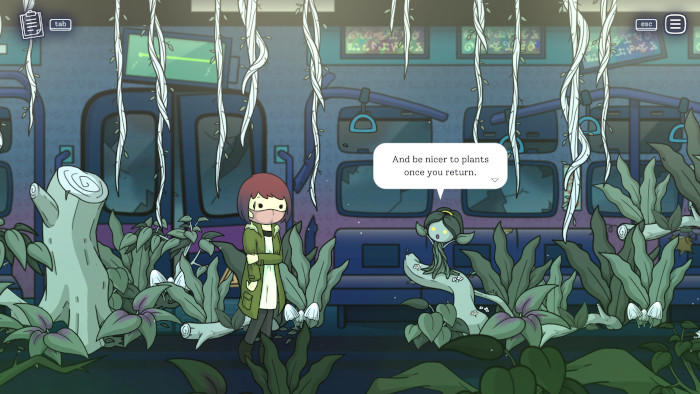
Be nice to your houseplants or they’ll lecture you later. (Credit: Rolling Glory Jam / fahmitsu. Fair use.)
That means that the quality of the writing is paramount. Unfortunately, this is where What Comes After falls short. The spirits you talk to share a few sentences about their lives, and may dispense brief platitudes like “Live your life as you see fit and cherish the good people around you.”
Vivi, it is revealed, has struggled with depression and suicidal ideation. These are difficult subjects to tackle, and the game does not do them justice with its fortune cookie wisdom.
What Comes After does offer a couple of sweet moments. You hear the stories of several animals, for example, and encounter a mystical chef who serves very special treats. Some scenes are beautifully illustrated (other scenes are very visually repetitive).
Overall, while it’s clearly a labor of love by a talented team of indie developers, this is one trip to the great beyond you can sit out.
Gyakuten Kenji 2 a.k.a. Ace Attorney Investigations 2, is the Japanese-only sequel to Ace Attorney Investigations: Miles Edgeworth. The game’s plot immediately follows the events of the predecessor. Again, you take control of persecutor Miles Edgeworth to investigate and solve many different cases, together with his young assistant Kay Faraday and his subordinate policeman Dick Gumshoe. Previously having smashed an international smuggling ring, they are given no break and are immediately caught up in new cases to investigate. Their efforts slowly uncover a conspiracy that goes all the way up the prosecutorial chain of authority.
An impressive display of fan labour
First of all, this is an English review of a game that was only officially released in Japan. This is only possible, because of an amazing fan translation.
The quality of the translation is just astonishing. Beyond the translation of dialogue, it also overhauls images and 3D textures for the English language and features original voice acting work for new characters. It is faithful to previous official English translations. But the overall style isn’t forcefully imitated either. When it comes to introducing new characters with unique quirks, the transition is seamless.
This translation would be indistinguishable from previous translations for the Ace Attorney series if it wasn’t for the occasional fandom insider reference. After all, this is a translation made by fans for fans.
Seriously, if doubts about the quality of this fan translation are holding you back—please play this game! I promise, you will enjoy it.
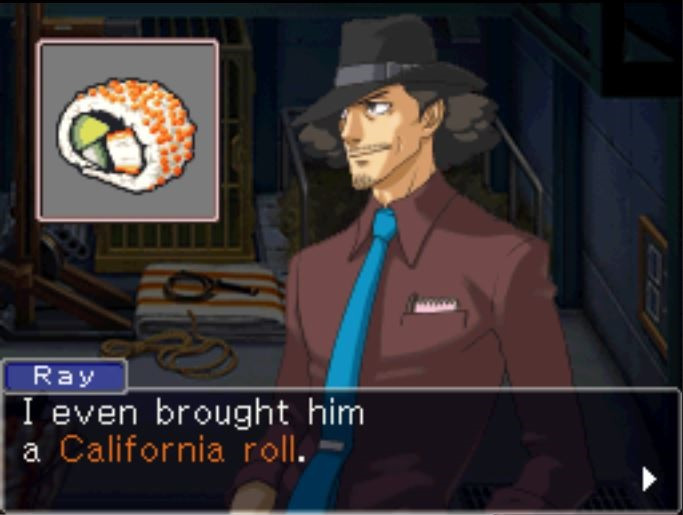
I’ll take one (1) California roll, please! (Credit: Capcom. Fair use.)
Declaring war on unjust justice
This sequel greatly extends its predecessor’s themes of the incongruence between the law and genuine justice.
In this game, we will see Edgeworth consciously abandoning the von-Karma-way of justice. Previously he sought to prove the defendant guilty in court, no matter what it takes. But now, he is increasingly distrustful of the methods of his mentor. His trust in the justice system is broken in the same way.
Together, with his friends’ help, he takes an adversarial stance against the highest prosecutorial authority in the country, which leads him to temporarily abandon his role as prosecutor and join forces with a defence attorney. And later, the law is directly weaponised against Miles. He was enforcing it against others, up until that point, but never had it turn against himself.
With this, the game manages to spell something out clearly that predecessors ever only managed subtextually: the law is inadequate in delivering justice, and the corrupt institutions enforcing it fail people regularly and perpetuate the harm they are meant to prevent.
However, the most interesting message of these games, that the law’s ability to deliver justice, is merely a belief, remains subtextual. There are hints in this direction. For example, one of Edgeworth’s rival prosecutors is quite reminiscent of the inquisition (their theme is even played on a pipe organ). And for another, the meeting room of the national highest prosecutorial authority looks like a church with stained glass windows. Unfortunately, however, the exploration of this theme seems to take a secondary role to the one mentioned above.
Furthermore, the game explores the struggle of stepping out of the shadow of one’s father. We learn more about Miles’ father, a defence attorney, and his struggle over having ended up a prosecutor. Additionally, the game features another startup prosecutor, who, throughout the game, has to learn to go against his father, to become a proper man of his profession. The scene where this finally happens makes for a very satisfying conclusion.
Structure
The overall storytelling structure remains largely intact with some improvements, but this also means that flaws from the predecessor persist.
One thing that is also true for the previous game is that the very linear structure allows for very tight storytelling. Usually, a bit of time passes between each entry in the series, but the story continues immediately. This is one of the major distinguishing factors between these spin-offs and the main entries in the series. One of these styles isn’t better than the other. But for an investigation game, it is arguably a better fit.
Beyond that, the game improves upon its predecessor by spacing otherwise familiar characters from the series out through the game, instead of cramming them all into a singular case. The focus here is a lot more on characters that were previously seen in just one case. So it’s nice to see those familiar faces again and see where they stand now.
Chapter parts, unfortunately, continue to vary in length heavily. This makes it hard to plan for game sessions. It’s frustrating to start playing a part, expecting it to last an hour, and then having to spend double of that time to reach the next save screen.
A few gameplay additions
Gameplay-wise the game largely continues with the things set up in the predecessor. Nothing was removed, and some new things were added.
A new addition is “Logic Chess”, a timed interrogation, where you have to extract information from people by examining what they are saying and finding contradictions. Having a mechanic with time pressure is a first for the series. Initially, this feels alien for this type of game, but over time I found that it accentuated the urgency of some of the situations quite well. On top of that, it makes you think a lot more about what path you want to go through the dialogue tree, while always feeling the pressure of the clock ticking down. It makes for a nice and refreshing challenge.
Another addition is how recreated crime scene investigations with “Little Thief” have been extended to cover multiple periods in time that you can switch to at will. It requires that you build a bigger mental image of the crime scene instead of just looking at everything one by one. This, however, can also lead to confusion. One frustrating aspect of this addition is that the exact same dialogue triggered by the same object at different points in time are duplicated, and thus you can’t skip through dialogue that you have already read. It can be confusing to stumble across already encountered dialogue and be puzzled if the intuition of having seen this before is real or not.
Otherwise, things have stayed the same. This is mostly fine, but I remain disappointed by the “Logic” feature. Combining literally two facts about the case for more insight isn’t that interesting or challenging. Sometimes the connection between the two facts is spurious, and you have to guess more than actually deduce.
Conclusion
Overall this is an excellent game—probably the best in the series up until that point. The predecessor left me somewhat cold, but this game alone makes playing it totally worth it.
8/10
Titles like Slay the Spire (2017), Griftlands (2019) and Inscryption (2021) have defined the genre of roguelike deck-building games where you combat enemies using playing cards. Can small indie studios still bring something new to the crowded genre?
With Meteorfall: Krumit’s Tale, Slothwerks, founded by developer Eric Farraro, is building on the success of its earlier Android/iOS game, Meteorfall: Journeys. Both games feature an art style inspired by Adventure Time and are set in a fantasy world that includes magic, monsters, aliens, and robots.
The intro screen for Krumit’s Tale depicts the outside of Krumit’s cozy house. After you start the game, the aging dungeon-master—who looks like he is part goblin, part elf—quickly invites you in to choose a character and to begin playing a game of cards.
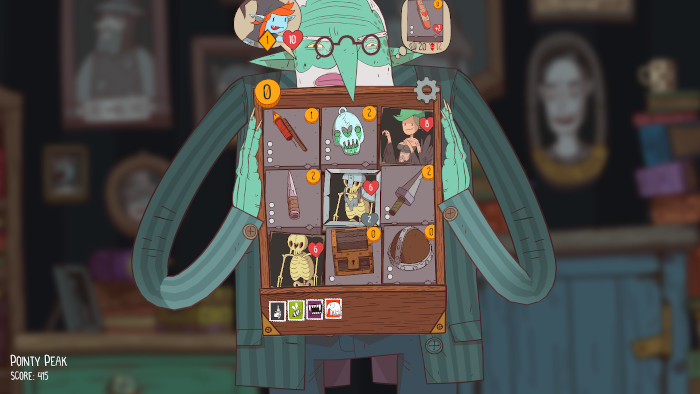
Dungeons are represented by a 3x3 grid of items, abilities, and enemies, with Krumit commenting on your actions in the background. (Credit: Slothwerks. Fair use.)
Dungeons on rails
You find yourself facing a 3x3 grid of cards, which include items, abilities, and enemies. You can discard cards to recover health and to gain coins. You can then spend coins to purchase items and abilities, which are added to your hand of up to four cards.
After cards are removed from the grid, Krumit deals new ones, until there are none left in the deck. Combat is turn-based and driven by simple stats (attack, defense, health). In most cases, you have the first move.
In spite of the title promising a “tale”, there’s little to no story as you advance from dungeon to dungeon randomly. Krumit himself is quite chatty and comments on many of your actions with one-liners; he also introduces bosses when they appear on the board.
As is typical for the roguelike genre, death is permanent. This makes for very tight “runs” that typically last 20-40 minutes.

One of the weaknesses of the game is that you don’t get to choose where the journey goes: Krumit navigates the map for you. (Credit: Slothwerks. Fair use.)
Deceptive simplicity
The game quickly introduces its core mechanics, while providing concise on-screen explanations for all cards. Each of the five unlockable heroes has access to a different set of abilities and items, forcing completely different play styles.
The wizard can burn enemies from afar, causing them to take damage as they move down the grid. The necromancer turns enemies into tombstone cards, which he can then raise to fight in his stead. The rogue is weak, but gains stealth against enemies with no neighbors on the board.
Enemies are similarly varied, from robots that self-destruct to town guards that prevent you from using melee weapons until you defeat them.
To knock out the most powerful bosses, you need luck on your side, but the game also requires strategy to make the best of the cards you’re dealt. After each victory, the game awards you with gems depending on how well you did. You can use these to purchase higher quality cards for the next dungeon.
The Verdict
I am really enjoying my time with Krumit’s Tale and have added it to my list of evergreens that I’m likely to return to time after time. Overall, I would give the game 4.5 stars, rounded up. Its core strengths are:
-
Excellent game design. There’s very little fat here—no tedious tutorials, no nested menus, no complicated rules. Krumit’s Tale is very easy to pick up but difficult to master; you’ll incorporate many new systems and strategies into your play as you go.
-
Gorgeous art direction. Heroes and enemies are lovingly drawn and animated; items are recognizable and distinct. If you like the Adventure Time art style, you’ll feel right at home—much credit to artist Evgeny Viitman.
Krumit himself (voiced by Adrian Vaughan) adds character and flair as well. After more than 10 hours of play, I’ve still not turned on the user preference to make him less chatty! Only the music, which sets a fitting tone of mystery and adventure, gets a bit repetitive. -
Attention to detail. Dungeons and items are accompanied by short but amusing quotes and descriptions. Little indicators appear in the user interface when you gain health or coins. I’ve encountered virtually no bugs and no crashes. Playing Krumit’s Tale feels smooth in the way only the best games do.
The most noticeable weaknesses are:
-
You have no agency about which dungeons to enter—Krumit makes that choice for you. That means you’ll often be dumped in dungeons that you simply have no chance of winning, even with a good strategy.
-
There’s no overarching motive or story. You’re just some adventurer who likes to defeat monsters and collect loot. The enemies, too, seem to have no articulated intentions other than to kill you.
-
As gorgeous as the artwork is, the game doesn’t attempt any real worldbuilding. There are no character sheets for our heroes or more detailed descriptions of the monsters, for example.
The combination of tight gameplay and shallow story is typical for mobile games. As Slothwerks makes the transition to large screen games, many players will expect a more fleshed out experience. Still, I would highly recommend Krumit’s Tale if you find the art style appealing and enjoy roguelike games that can, at times, be utterly unfair.
While I would love to see a native Linux version, I played Krumit’s Tale on Linux using Steam/Proton without issues.
Ich war lange bei Yelp. Sehr lange. Und dort habe ich alle Höhen und Tiefen seit der Übernahme von Qype mitgemacht. Yelp wurde, auch in meiner Heimatstadt, von sogenannten Community Managern am Leben gehalten und die Mitglieder vor Ort wurden zu Events eingeladen. Dieses Programm ist allerdings in Europa sehr schnell eingestellt worden und das war der Anfang vom Ende.
Immer mehr Funktionen, die in anderen Ländern ausgerollt worden sind, haben es nicht mehr in den deutschen Markt geschafft. Reservierungen, direkte Bestellungen von Gerichten zur Abholung oder die Anzeige von Ergebnissen der letzten Prüfung durch örtliche Behörden sind aus verschiedensten Gründen, für die manchmal Yelp nicht einmal die Verantwortung trägt, nicht vorhanden. Ob Yelp an den deutschen Datenschutzgesetzen oder an etwas anderem gescheitert ist wird nicht mehr kommuniziert, denn auch das deutschsprachige Blog wurde eingestellt.
Neue Restaurants oder Geschäfte sind nur noch vereinzelt oder gar nicht mehr auf Yelp zu finden. Es hat den Anschein als ob eine Bewertung nur noch bei TripAdvisor und Google zu finden ist. Facebook Bewertungen sind aus verschiedensten Gründe für mich kein Indikator und alle anderen Social Media Plattformen bieten eine Bewertungsmöglichkeit gar nicht erst an.
Mit der Zeit ist Yelp daher immer unzuverlässiger für mich geworden. Google kann ich nicht ernst nehmen (ein noch nicht eröffnetes Restaurant in meiner Nachbarschaft hat schon 11 Bewertungen) und zu TripAdvisor habe ich noch keine Meinung. Leider ist der Open-Source-Bereich in diesem Feld so gut wie gar nicht vertreten. Es wird daher wohl für mich auf ein Try-and-Error-Prinzip hinauslaufen.
Was ist denn hier passiert? Brauchten die Beteiligten etwa finanzielle Mitte und haben sich vom Aufguss der Reihe einen Geldsegen versprochen? Der Anfang des Films hat mich schon sehr verwirrt. Die Szenen springen wild in der Welt umher und werden dann nur mit Mühe zu einer Story versponnen.
Die Actionanteile des Films sind solide, die Story eher nicht. Und ich kann nicht einmal das Ende des Films Spoilern, denn dieses habe ich nicht mehr geschaut. Finger weg von diesem Film. Ein solches Ende (hoffentlich) hat diese Reihe nicht verdient.
看了某篇文章推荐所以就试了试,还行吧!每次打开都有那种名言警句,挺不错;记录自己的想法能够让自己的宠物鸡获得能量,有了足够的能量它就会外出探险,探险过程中记录会让它快点回来;回来以后它会分享它的发现,就是那种我们都很熟悉的东西它都有它自己的理解,就超可爱,这个时候你就要告诉它这东西本质是怎么回事之类的,挺好玩的。
搜索量表的时候发现的,最开始发现的还是它的中文机翻版(不得不说,好多网站都在机器翻译英语的文章,弄得一塌糊涂,真是互联网上的糟粕啊)。每一篇文章都是有撰稿人的,写作偏科普,里面的知识可能不一定精确,简单了解还好,如果是想好好学习则需要对照更多材料。
If you’ve ever played one of the classic Sierra point and click adventure games (e.g., Space Quest) and thought “Gee, the one thing this game really needs to be more fun is more random ways to die!”, then House may be your personal game of the year.
You’re a young girl in the eponymous house which is, of course, haunted. Every day you awaken in a home that is newly trying to kill you and your family. Will you save everyone, or will you be the one who does the killing?
The game uses very simple but expressive pixel art, with special attention to death and gore animations. You walk from room to room, pick up items and weapons, and pursue one of the multiple endings. If you die (which you will, many times), you wake up again.
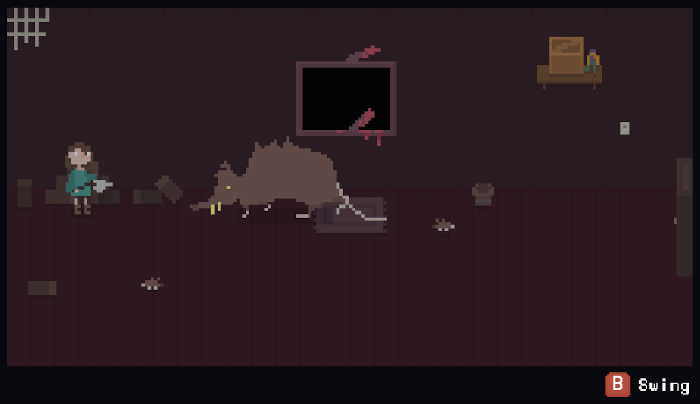
The rodent of unusual size in the basement is the least of your problems. (Credit: Bark Bark Games. Fair use.)
This is an action-adventure—timing and precision do matter. Each run only takes a few minutes, and some aspects of the environment change subtly over time. To survive, you have to make mental (or written) note of what you’ve tried, and where you’ve died.
The game has received many positive reviews on Steam (fluctuating between “Very Positive” and “Overwhelmingly Positive”). I spent about an hour with it before getting frustrated by the repetition and heading to YouTube to watch the endings. Don’t let my experience dissuade you, though. There is a lot to discover in this $5 game, including interesting details about each character—if you don’t mind dying many times in a short loop.
After you die, if your spirit is out of balance, you spend time in limbo as a ghost with too much energy, or as a reaper with too little. Reapers collect the excess energy of ghosts, helping them to pass on—until they have collected enough energy to pass on themselves.
And so is is that a young girl named Lavender finds herself waking up in Grimm’s Hollow as a reaper tasked by the grim reaper (AKA Grimm) with collecting ghosts. Lavender is understandably skeptical of this assignment, but plays along in hopes that she may find her brother Timmy.
Grimm’s Hollow is a freeware indie game by developer ghosthunter, made with the popular RPG Maker software. Much of the game consists of exploring three caves, in which you encounter fellow reapers and fight ghosts in turn-based battles with quick-time events.
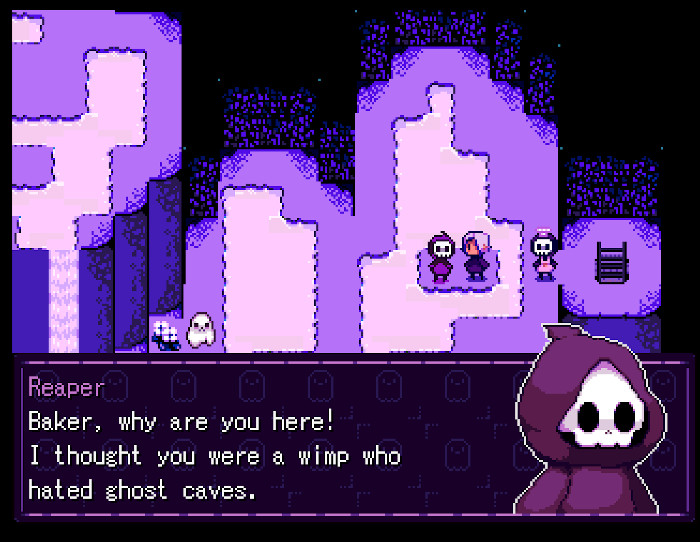
The battle-shy baker is tasked by Grimm to accompany Lavender as part of her training as a reaper. (Credit: ghosthunter. Fair use.)
The combat system can be a bit frustrating at first, but once you master it, you’re unlikely to have any issues until the final battle. What makes Grimm’s Hollow a gem of a game is the attention to the story, the worldbuilding, and the characters.
For example, to heal, you collect treats such as “Spooky Cookies” and “Deathlicious Donuts”, all rendered in beautiful pixel art. The baker has made a special deal with Death that he can avoid ghost battles if he just keeps the goods coming.
Grimm’s Hollow features four different endings. If you lose the final battle, make sure to retry until you get at least one of the good endings. The game also offers save slots, but you’re unlikely to need them once you’ve mastered the initial learning curve. All in all, it’s a 3-4 hour experience, and a wonderful treat that should not be missed.
Although this is a Windows game, I played it on Linux using Steam/Proton with only one minor issue: the top GNOME menu bar stayed visible in full-screen mode (without overlapping with the game’s contents).
If you love the game and want to express your appreciation for the developer, you can purchase an art pack on Steam or itch.io.
